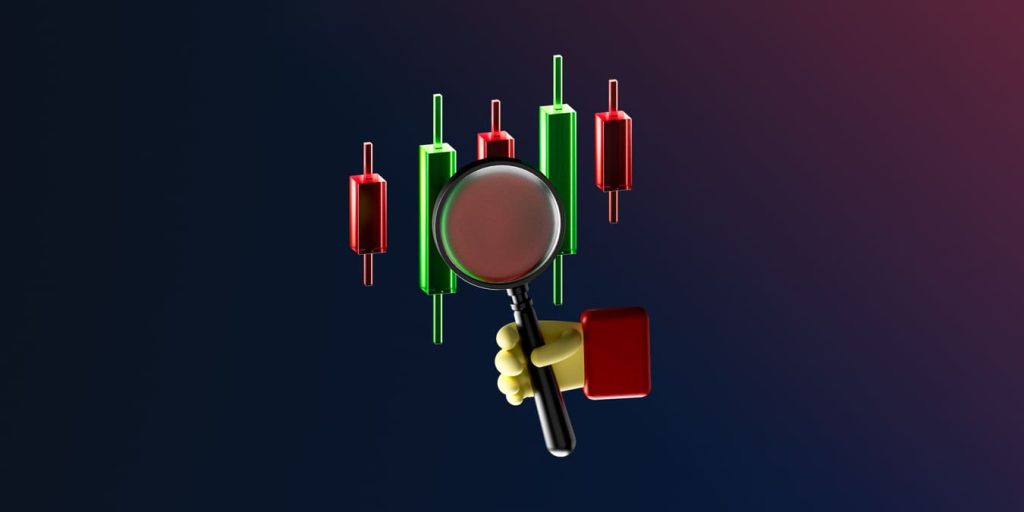
วิธีการซื้อขาย Forex: คู่มือฉบับสมบูรณ์
เนื้อหา
การเทรด Forex ช่วยให้นักลงทุนสามารถเก็งกำไรจากการเปลี่ยนแปลงของอัตราแลกเปลี่ยนเงินตราต่างประเทศผ่านการขายและซื้อสกุลเงินต่างๆ นักลงทุนสามารถเปิดสถานะ Short หรือ Long ในคู่สกุลเงินต่างๆ เพื่อสร้างโอกาสในการทำกำไรจากตลาดขาขึ้นและขาลง สิ่งสำคัญที่ต้องจำไว้คือ เมื่อมีโอกาสได้รับผลตอบแทน ความเสี่ยงก็ย่อมเกิดขึ้นเช่นกัน ราคาในตลาด Forex สามารถเคลื่อนไหวได้อย่างรวดเร็ว และเลเวอเรจไม่เพียงแต่เพิ่มผลกำไร แต่ยังเพิ่มการขาดทุนอีกด้วย
คำศัพท์สำคัญในการเทรด Forex
ก่อนที่จะลงรายละเอียดเกี่ยวกับการซื้อขาย Forex ต่อไปนี้เป็นคำศัพท์ทั่วไปบางคำที่คุณจะพบ:
- คู่สกุลเงิน:คู่สกุลเงินที่ประกอบเป็นเครื่องมือซื้อขายเรียกว่าคู่สกุลเงินฟอเร็กซ์ ตัวอย่างทั่วไปได้แก่ EUR/USD, GBP/JPY เป็นต้น ในคู่สกุลเงิน สกุลเงินฐานจะปรากฏก่อน ในขณะที่สกุลเงินอ้างอิงจะปรากฏรองลงมา
- พิพ:การเปลี่ยนแปลงราคาที่น้อยที่สุดในคู่สกุลเงินใดๆ สำหรับคู่สกุลเงินหลักส่วนใหญ่ จะเป็นทศนิยมตำแหน่งที่สี่ หรือ 0.0001 100 pips เท่ากับการเปลี่ยนแปลงราคา 1 เปอร์เซ็นต์ หากบัญชีของคุณเป็นดอลลาร์สหรัฐฯ ค่า pip สำหรับคู่สกุลเงินอย่าง EUR/USD ใน 1 ล็อตมาตรฐาน และ 0.01 ล็อตไมโคร จะอยู่ที่ 10 ดอลลาร์ และ 0.1 ดอลลาร์ ตามลำดับ อย่างไรก็ตาม ค่านี้จะแตกต่างกันไปในแต่ละคู่สกุลเงิน เช่น GBP/JPY และ AUD/CAD สำหรับบัญชีประเภทเดียวกัน
- เลเวอเรจ:ความสามารถในการควบคุมสถานะขนาดใหญ่โดยใช้เงินทุนจำนวนเล็กน้อยจากโบรกเกอร์ของคุณ ซึ่งจะเพิ่มทั้งกำไรและขาดทุนตามสัดส่วน ทั่วไป เลเวอเรจ ในตลาด Forex มีอัตรา 50:1 สูงสุดถึง 200:1 โบรกเกอร์บางรายเสนออัตราสูงถึง 2,000:1
- ทุน:มูลค่ารวมของบัญชีการซื้อขายของคุณซึ่งรวมถึงกำไรหรือขาดทุนจากสถานะเปิดของคุณตลอดจนยอดคงเหลือเงินฝากของคุณ
- ระยะขอบ:จำนวนเงินทุนที่โบรกเกอร์ต้องการเป็นหลักประกันในการเปิดสถานะแบบเลเวอเรจ ยิ่งเลเวอเรจสูง ข้อกำหนดมาร์จิ้นก็จะยิ่งต่ำลง
- ล็อต/ล็อตมาตรฐาน:หน่วยมาตรฐานสำหรับการวัดขนาดสถานะ ล็อตมาตรฐานควบคุมมูลค่าสกุลเงินหลัก 100,000 ดอลลาร์สหรัฐฯ ล็อตขนาดเล็กและมินิล็อตควบคุมมูลค่าที่น้อยกว่า จากมาร์จิ้นและเลเวอเรจของคุณ คุณสามารถคำนวณขนาดล็อตสูงสุดที่จะใช้ในบัญชีใดบัญชีหนึ่งได้
- ตัวอย่างเช่น หากคุณมีมาร์จิ้น 1,000 ดอลลาร์สหรัฐฯ และเลเวอเรจ 100 เท่า คุณสามารถเปิดการซื้อขายมูลค่า 100,000 ดอลลาร์สหรัฐฯ (1,000 ดอลลาร์สหรัฐฯ x 100) อย่างไรก็ตาม ล็อตมาตรฐานมีมูลค่า 100,000 ดอลลาร์สหรัฐฯ ดังนั้น ขนาดล็อตสูงสุดที่คุณสามารถใช้ได้ในบัญชีประเภทนี้คือ 1 ล็อต (100,000 ดอลลาร์สหรัฐฯ/100,000 ดอลลาร์สหรัฐฯ) คุณสามารถใช้สูตรนี้สำหรับบัญชีขนาดอื่นๆ ที่มีเลเวอเรจต่างกันได้ โดยขนาดล็อต = (มาร์จิ้น x เลเวอเรจ) / 100,000
- การแพร่กระจาย: The difference between the buy and sell price quoted for a currency pair at any given time. This is how brokers make their money. การแพร่กระจายs vary depending on account type, broker, and market conditions. When setting your take profit (tp) or stop loss (sl) it is recommended to factor in the spread.
- ตำแหน่งยาว:เมื่อคุณซื้อคู่สกุลเงินโดยเก็งกำไรว่าสกุลเงินหลักจะมีมูลค่าเพิ่มขึ้นเมื่อเทียบกับราคาอ้างอิง คุณมองหาการขายในราคาที่สูงขึ้นเพื่อทำกำไร
- ตำแหน่งสั้น:เมื่อคุณขายคู่สกุลเงินโดยเก็งกำไรว่าสกุลเงินหลักจะมีมูลค่าลดลงเมื่อเทียบกับราคาอ้างอิง คุณมองหาการซื้อกลับในราคาที่ต่ำกว่าเพื่อทำกำไร
- การลื่นไถล: การลื่นไถล occurs when your trades are executed are lower or higher prices than your intended prices. This usually occurs during high volatility news like the Consumer Price Index (CPI), NFP (Non-Farm Payrolls), etc. When encountered, it could lead to higher-than-expected losses.
คำศัพท์สำคัญเหล่านี้จะช่วยให้คุณเข้าใจแนวคิดพื้นฐานเกี่ยวกับ Forex ที่กล่าวถึงในคู่มือนี้ มาดูขั้นตอนการเตรียมการเทรด Forex ครั้งแรกของคุณอย่างเหมาะสมกัน
วิธีเตรียมตัวสำหรับการเทรด Forex ครั้งแรกของคุณ
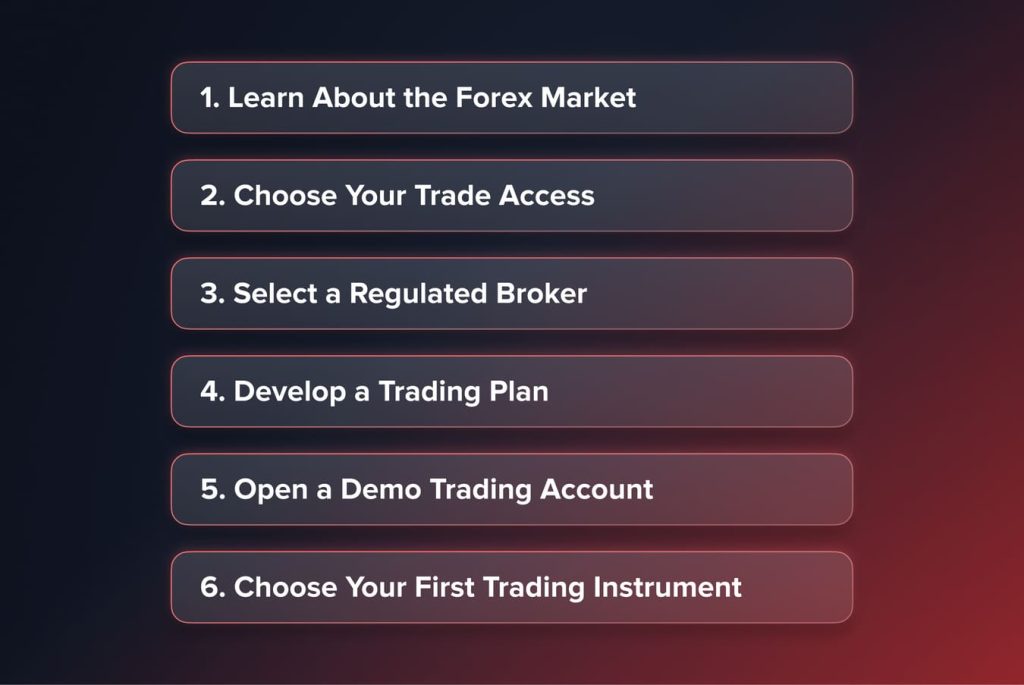
1. เรียนรู้เกี่ยวกับตลาด Forex
วิธีที่ดีที่สุดในการเริ่มเส้นทาง Forex ของคุณคือการเพิ่มพูนความรู้เกี่ยวกับการทำงานของตลาด ลองใช้เวลาศึกษาแนวคิดหลักๆ ของ Forex เช่น ปัจจัยที่ขับเคลื่อนอัตราแลกเปลี่ยน ผู้เข้าร่วมตลาด ประเภทของคำสั่งซื้อขาย แพลตฟอร์มการซื้อขาย ศึกษาปฏิทินเศรษฐกิจเพื่อทำความเข้าใจเหตุการณ์ที่จะเกิดขึ้นซึ่งอาจส่งผลกระทบต่อความผันผวน นอกจากนี้ คุณควรคุ้นเคยกับวิธีการวิเคราะห์ทางเทคนิคและพื้นฐานด้วย
วิธีที่ดีในการเริ่มต้นคือการเข้าเรียนหลักสูตรฟอเร็กซ์เพื่อการศึกษาที่ออกแบบมาสำหรับผู้เริ่มต้น โบรกเกอร์ของคุณอาจมีโปรแกรมฝึกอบรมและเว็บบินาร์ คุณสามารถอ่านหนังสือ วิดีโอแนะนำ และเรียนหลักสูตรออนไลน์ฟรีได้ ฝึกฝนการวิเคราะห์ทางเทคนิคบนกราฟสาธิตโดยใช้รูปแบบกราฟ
You may also like
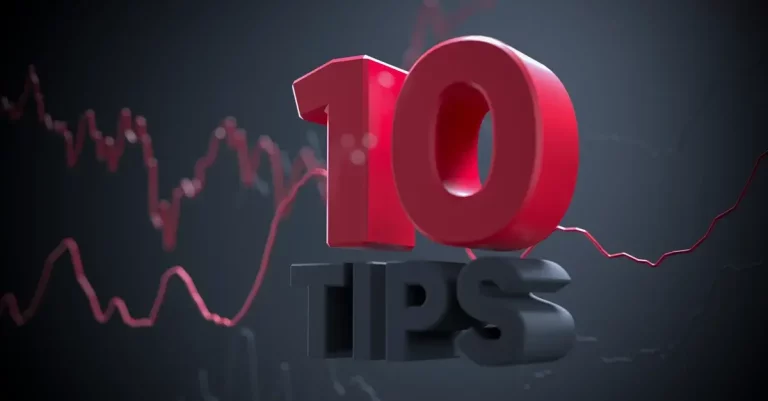
2. เลือกสินทรัพย์การค้าของคุณ
การซื้อขายฟอเร็กซ์ทุกประเภทเกี่ยวข้องกับการแลกเปลี่ยนสกุลเงินหนึ่งเป็นอีกสกุลเงินหนึ่ง สองวิธีที่พบได้บ่อยที่สุดคือการใช้ CFD หรือการซื้อขายคู่สกุลเงินในตลาดสปอตโดยตรง ในกรณีแรก จะไม่มีกรรมสิทธิ์ในสินทรัพย์อ้างอิงทางกายภาพ แต่สามารถเก็งกำไรจากการเคลื่อนไหวของราคาได้ คุณยังสามารถซื้อขายสัญญาซื้อขายล่วงหน้าหรือออปชันสกุลเงินได้ หากโบรกเกอร์ของคุณให้บริการ ขั้นแรก ตรวจสอบให้แน่ใจว่าบัญชีที่คุณเปิดนั้นเหมาะสมกับวัตถุประสงค์ ระดับประสบการณ์ และระดับความเสี่ยงที่คุณยอมรับได้มากที่สุด
3. เลือกโบรกเกอร์ที่ได้รับการควบคุม
ขั้นแรก ควรศึกษาข้อมูลโบรกเกอร์ Forex ชั้นนำหลายๆ แห่งอย่างละเอียดถี่ถ้วนก่อนตัดสินใจลงทุน คุณต้องการโบรกเกอร์ที่น่าเชื่อถือและมีประวัติการทำงานที่ผ่านการพิสูจน์แล้ว ได้รับอนุญาตจากหน่วยงานทางการเงินที่มีชื่อเสียง เช่น FCA, CySEC หรือ ASIC พิจารณาปัจจัยสำคัญทั้งหมด เช่น ต้นทุน แพลตฟอร์ม เครื่องมือ ชื่อเสียง และกฎระเบียบ ปัจจัยเหล่านี้ส่วนใหญ่จะช่วยให้คุณเปิดบัญชีทดลองเพื่อทดลองเทรดได้ การใช้เวลาอย่างคุ้มค่าในการพิจารณาโบรกเกอร์เหล่านี้ถือเป็นเรื่องที่ดี เพราะพวกเขาจะเป็นพันธมิตรหลักในการเทรดของคุณ
4. พัฒนาแผนการซื้อขาย
เตรียมแผนการเทรด Forex ที่ครอบคลุมก่อนการลงทุนด้วยเงินทุนจริง กำหนดเป้าหมายระยะสั้นและระยะยาวของคุณ กำหนดกลยุทธ์ของคุณให้ชัดเจน รวมถึงปัจจัยทางเทคนิคและปัจจัยพื้นฐานที่คุณจะติดตาม กำหนดขนาดสถานะและการตั้งค่าความเสี่ยง/ผลตอบแทนที่เหมาะสมสำหรับการเริ่มเทรด พิจารณาความเสี่ยงที่คุณจะยอมรับและวิธีจัดการความเสี่ยงเหล่านั้นอย่างเหมาะสม แผนที่ดีจะช่วยให้คุณดำเนินงานตามแผนและมีวินัยแม้ในยามที่ราคาผันผวน กลับไปดูแผนของคุณและอัปเดตเมื่อคุณเรียนรู้และสั่งสมประสบการณ์มากขึ้น
5. เปิดบัญชีซื้อขายทดลอง
บัญชีเทรดเดโมมีความสำคัญเพราะช่วยให้คุณฝึกฝนและจำลองการเทรดได้โดยไม่ต้องเสี่ยงเงินทุน ฝึกฝนการเปิดและปิดการเทรด การตั้งคำสั่ง Stop-loss และ Limit รวมถึงการวิเคราะห์บนกราฟเดโม นำกลยุทธ์ของคุณไปประยุกต์ใช้กับตลาดจริงโดยไม่มีแรงกดดันหรือผลกระทบใดๆ นี่เป็นวิธีที่ปลอดภัยที่สุดในการทดสอบความรู้และเปิดช่องว่างก่อนการเทรด บัญชีเดโมจากโบรกเกอร์อาจมีการจำกัดเวลา ดังนั้นจึงเป็นช่วงเวลาที่ดีในการศึกษาหาความรู้
6. เลือกเครื่องมือการซื้อขายแรกของคุณ
ตลาด Forex มีคู่สกุลเงินหลายร้อยคู่ที่ซื้อขายกันทั่วโลก ผู้ที่ต้องการเริ่มต้นด้วยสถานะการเทรดที่น้อยกว่า ควรพิจารณาการเทรดคู่สกุลเงินหลักๆ อย่างจริงจัง เช่น UDS, EUR, GBP และ JPY เนื่องจากมีสภาพคล่องสูงและสเปรดต่ำ ตราสารยอดนิยมอย่าง EUR/USD และ GBP/USD มีสภาพคล่องสูงมากและมีการรายงานข่าวบ่อยครั้ง
ด้วยเหตุนี้ พวกเขาจึงมีเงื่อนไขที่เหมาะสมอย่างยิ่งในการประยุกต์ใช้และฝึกฝนการวิเคราะห์ของตนเอง ควรสั่งสมประสบการณ์กับคู่สกุลเงินเหล่านี้เพียงไม่กี่คู่ก่อนที่จะซื้อขายคู่สกุลเงินรองและสกุลเงินต่างประเทศที่มีผู้เข้าร่วมน้อยกว่า การวิเคราะห์ที่เหมาะสมและ การจัดการความเสี่ยงที่เหมาะสม มักจะเหนือกว่าการเลือกคู่ "พิเศษ" ใดๆ
วิธีดำเนินการเทรด Forex ครั้งแรกของคุณ
เมื่อเตรียมการเสร็จเรียบร้อยแล้ว ก็ถึงเวลาเริ่มการซื้อขายจริงครั้งแรกของคุณ คำนึงถึงสิ่งต่อไปนี้ขณะที่คุณวิเคราะห์โอกาสและสำรวจสภาวะตลาดจริง ท้าทายสมมติฐานอย่างต่อเนื่องด้วยการเรียนรู้อย่างต่อเนื่องเช่นกัน
1. การวิเคราะห์ทางเทคนิคและพื้นฐาน
การวิเคราะห์ทั้งแผนภูมิในระยะสั้นและแนวโน้มในระยะยาวจะช่วยระบุโอกาสในการซื้อขาย ตัวบ่งชี้ทางเทคนิค เผยให้เห็นรูปแบบที่เกิดขึ้นตามความผันผวนของค่าเงิน การวิเคราะห์ปัจจัยพื้นฐานจะพิจารณาข้อมูลเศรษฐกิจเพื่อคาดการณ์ว่าข้อมูลเหล่านั้นอาจส่งผลกระทบต่ออัตราแลกเปลี่ยนอย่างไร ผสมผสานมุมมองทั้งสองเข้าด้วยกันเพื่อให้ได้มุมมองที่ครอบคลุมที่สุด เปิดใจให้กว้าง - กราฟเพียงอย่างเดียวไม่พิจารณาข่าวที่ไม่คาดคิด ขณะที่ปัจจัยพื้นฐานมองข้ามมุมมองทางเทคนิคของเทรดเดอร์รายอื่น เป้าหมายของคุณคือการหาจุดบรรจบระหว่างสองสิ่งนี้
2. การตัดสินใจซื้อหรือขาย
เมื่อสัญญาณวิเคราะห์ปรากฏขึ้น ให้ใช้กลยุทธ์ของคุณพิจารณาว่าสภาวะการณ์เอื้ออำนวยต่อการซื้อ (Long) หรือการขาย (Short) พิจารณาปัจจัยต่างๆ เช่น ทิศทางแนวโน้ม โมเมนตัม แนวรับและแนวต้าน จดบันทึกเหตุผลในการตัดสินใจเข้าซื้อขาย ตั้งจุดตัดขาดทุนเพื่อป้องกันทันทีเพื่อป้องกันการเคลื่อนไหวที่ไม่พึงประสงค์ ตั้งเป้าหมายหรือจุดทำกำไรที่คาดการณ์ไว้ไว้เหนือหรือต่ำกว่าแนวรับ เชื่อมั่นในสถานะการลงทุนที่ผ่านการวิเคราะห์ข้อมูลมาเป็นอย่างดีเท่านั้น
3. การดำเนินการด้วยการกำหนดขนาดตำแหน่งที่เหมาะสม
เริ่มต้นจากจำนวนน้อยๆ ที่ 0.01 ล็อต หรือไมโครล็อต จนกว่าจะพอใจกับยอดคงเหลือที่แท้จริง เพิ่มหรือลดสถานะการลงทุนโดยพิจารณาจากความผันผวนและระดับความเสี่ยงที่คุณยอมรับได้ รักษาวินัยโดยคำนึงถึงพารามิเตอร์ความเสี่ยงทั้งหมดตามแผนของคุณ รวมถึงขีดจำกัดการขาดทุนรวมรายวัน การกำหนดขนาดสถานะการลงทุนที่เหมาะสมควบคู่ไปกับการตั้ง Stop Loss จะช่วยให้เกิดการขาดทุนระยะสั้นได้บ้าง ขณะเดียวกันก็ป้องกันการสูญเสียเงินจำนวนมากที่อาจทำลายบัญชีได้ เป้าหมายของคุณคือการเติบโตอย่างยั่งยืน ไม่ใช่การร่ำรวยชั่วข้ามคืน
4. การติดตามการเคลื่อนไหวของราคาอย่างใกล้ชิด
ติดตามปฏิทินเศรษฐกิจอย่างสม่ำเสมอเพื่อรับรู้แนวโน้มตลาดที่กำลังจะมาถึง เฝ้าติดตามการซื้อขายของคุณอย่างใกล้ชิด โดยเฉพาะอย่างยิ่งในช่วงที่มีข่าวสำคัญๆ ออกมา เตรียมพร้อมที่จะจำกัดจุดตัดขาดทุนหรือขายหุ้นทันทีหากการวิเคราะห์ผิดพลาด คว้ากำไรไว้ล่วงหน้าโดยการปรับฐานจากจุดต่ำสุด หรือขายหุ้นทั้งหมดหากเกินเป้าหมาย มีความยืดหยุ่นและความอดทนที่จะยอมรับกำไรเล็กน้อยแทนที่จะขาดทุนมากหากไม่แน่ใจ ด้วยประสบการณ์ คุณจะมองเห็นรูปแบบที่เป็นประโยชน์ต่อคุณเช่นกัน
5. การปิดการซื้อขายอย่างเหมาะสม
อย่ายึดติดกับสถานะทางอารมณ์ ปิดการเทรดที่ทำกำไรได้ด้วยการทำกำไรอย่างเป็นระบบตามแผนที่วางไว้ สำหรับเทรดที่ขาดทุน อย่าเฉลี่ยราคาลง เคารพจุดตัดขาดทุนและออกจากตลาดทันทีหากถูกเทรด โดยไม่ต้องตั้งคำถามใดๆ การปฏิบัติตามแผนอย่างเคร่งครัดจะช่วยให้คุณมีสติและทำซ้ำได้ ทบทวนความแม่นยำของการซื้อขายแต่ละครั้งและอารมณ์ของคุณในระหว่างนั้นเพื่อการเรียนรู้ เทรดเดอร์ที่ประสบความสำเร็จจะประเมินกลยุทธ์และตนเองอย่างต่อเนื่อง พร้อมกับเปิดใจรับการพัฒนา
กลยุทธ์ Forex ยอดนิยม
เมื่อความเชี่ยวชาญของคุณเติบโตขึ้น ต่อไปนี้คือแนวคิดยอดนิยมบางประการที่คุณสามารถสำรวจได้:
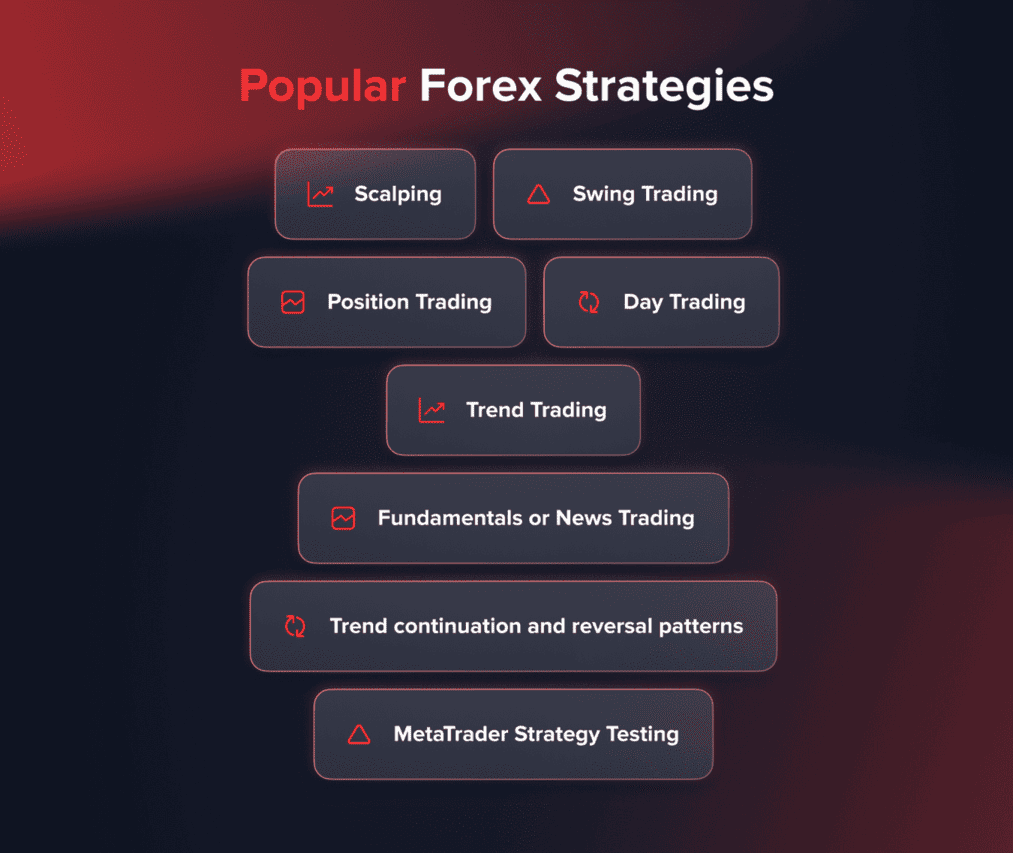
- การสเกลปิ้ง: ทำกำไรเล็กๆ น้อยๆ หลายครั้ง เพียงไม่กี่ pips ต่อครั้ง จากการเคลื่อนไหวระยะสั้นๆ ซึ่งมักจะเกิดขึ้นภายในช่วงการซื้อขายเดียว นักเก็งกำไรระยะสั้นจะถือครองคำสั่งซื้อขายตั้งแต่ไม่กี่วินาทีไปจนถึงไม่กี่นาที ขึ้นอยู่กับความเร็ว กฎเกณฑ์ขนาดตำแหน่ง และวินัย
- การซื้อขายแบบสวิง:เทรดเดอร์แบบสวิงมักจะถือครองสถานะการเทรดไว้หลายวันถึงหลายสัปดาห์ มองหากำไรอย่างรวดเร็ว 30-200 pips จากราคาแกว่งตัวระยะสั้นระหว่างวัน ใช้ประโยชน์จากกรอบเวลาที่สั้นลงและระดับ Fibonacci retracement เพื่อเพิ่มสถานะการเทรดในขณะที่การเทรดดำเนินไปในทิศทางของคุณ จนกว่าคุณจะมั่นใจว่ากำลังเกิดการกลับตัว
- การซื้อขายแบบตำแหน่ง:ผู้ค้าตำแหน่งไม่ต้องกังวลเกี่ยวกับการเคลื่อนไหวของราคาในระยะสั้นเนื่องจากพวกเขาสามารถถือการซื้อขายได้ตั้งแต่หลายสัปดาห์ถึงหลายเดือนหรือแม้กระทั่งหนึ่งปีเพื่อเพิ่มผลกำไรให้สูงสุด
- การซื้อขายรายวัน: ในฐานะเดย์เทรดเดอร์ คุณมีหน้าที่รับผิดชอบในการเข้าและปิดการซื้อขายภายในวันซื้อขาย ซึ่งหมายความว่าสถานะที่เปิดอยู่ของเดย์เทรดเดอร์จะไม่เลื่อนไปยังวันซื้อขายถัดไป
- การซื้อขายตามแนวโน้ม: ขี่การเคลื่อนไหวของสกุลเงินในแนวโน้มขาขึ้นหรือแนวโน้มขาลงที่ชัดเจนโดยวิเคราะห์แผนภูมิกรอบเวลาที่สูงกว่าและยืนยันสัญญาณแนวโน้ม
- ปัจจัยพื้นฐานหรือการซื้อขายข่าว:คาดการณ์ปฏิกิริยาต่อการประกาศตามกำหนดการโดยการวางสถานะก่อนการเผยแพร่และออกทันที ข้อได้เปรียบเกิดจากการทำความเข้าใจผลกระทบของเหตุการณ์ที่คาดการณ์ไว้ การเผยแพร่ข้อมูลพื้นฐานเหล่านี้ประกอบด้วย ดัชนีราคาผู้บริโภค (CPI), การจ้างงานนอกภาคเกษตร (NFP), การเผยแพร่ข้อมูลของ FOMC เป็นต้น
- รูปแบบการต่อเนื่องของแนวโน้มและการกลับตัว: รูปแบบต่างๆ เช่น ธง ธงสามเหลี่ยม และรูปแบบสามเหลี่ยม เป็นตัวอย่างทั่วไปของรูปแบบต่อเนื่อง และมักเกิดขึ้นก่อนการเคลื่อนไหว ตัวอย่างของรูปแบบการกลับตัว ได้แก่ หัวและไหล่, ยอดคู่, ก้นคู่ ฯลฯ ระบุพฤติกรรมก่อนหน้า และมองหารูปแบบที่เกิดขึ้นซ้ำบนกราฟ
- การทดสอบกลยุทธ์ MetaTrader: เขียนโค้ดและทดสอบย้อนหลังหุ่นยนต์เทรด ตัวบ่งชี้ และอัลกอริทึมบนข้อมูลราคาในอดีตเพื่อการปรับแต่งให้เหมาะสมที่สุด ประเมินความเป็นไปได้ก่อนใช้งานจริง
You may also like
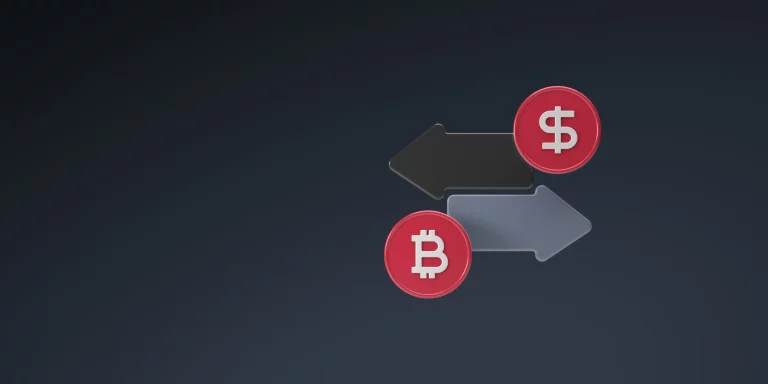
พัฒนาแนวทางของคุณอย่างต่อเนื่องควบคู่ไปกับการสะสมความรู้และประสบการณ์จริงในสภาวะตลาดจริง ปรับปรุงส่วนต่างๆ ที่อาจยังไม่ดีนัก แต่ให้กลยุทธ์โดยรวมเรียบง่าย วินัยทางเทคนิคและความเสี่ยงยังคงมีความสำคัญเช่นเคย
ความสำคัญของการจัดการความเสี่ยงและการเรียนรู้อย่างต่อเนื่อง
แม้ว่ากลยุทธ์และโอกาสการเทรดของคุณจะพัฒนาอย่างต่อเนื่องตลอดเส้นทาง Forex ของคุณ แต่การบริหารความเสี่ยงอย่างเหมาะสมควรเป็นรากฐานแห่งความสำเร็จที่มั่นคงของคุณ ประเด็นสำคัญที่ควรคำนึงถึง:
- การจัดการเงิน:ควบคุมความเสี่ยงโดยรวมต่อการซื้อขายให้เหลือเพียงเปอร์เซ็นต์เล็กน้อย (1-2%) ของบัญชี ด้วยการกำหนดขนาดสถานะและจุดหยุดการเทรดที่เข้มงวด อย่าเสี่ยงเกิน 2-5% ของยอดคงเหลือในบัญชีในช่วงเวลา 24 ชั่วโมง เพื่อหลีกเลี่ยงความเสียหาย
- วินัยทางอารมณ์: การไม่ยึดติดกับผลลัพธ์เป็นสิ่งสำคัญ ยึดมั่นกับสัญญาณของแผนที่พิสูจน์แล้วของคุณเพียงอย่างเดียว แม้ว่าจะมีขาดทุนหรือกำไรผันผวนชั่วคราว ปล่อยให้การขาดทุนดำเนินไปจนกว่าจะลดลง อย่าเฉลี่ยให้ลดลง
- ขีดจำกัดการถอนเงิน: กำหนดวงเงินถอนสูงสุดของพอร์ตโฟลิโอ (เช่น 15-20%) ที่จะไม่เกินก่อนประเมินแนวทางการลงทุนของคุณอีกครั้ง ปกป้องเงินทุนเพื่ออายุยืนยาว
- การบันทึกข้อมูล: วิเคราะห์การซื้อขายทั้งหมดอย่างสม่ำเสมอโดยคำนึงถึงสัญญาณ วิเคราะห์คุณภาพ อารมณ์ และปัจจัยอื่นๆ ปรับปรุงและเพิ่มประสิทธิภาพกลยุทธ์อย่างต่อเนื่องจากข้อมูลเชิงคุณภาพอันมีค่านี้
- การศึกษาต่อเนื่อง: การเรียนรู้อย่างต่อเนื่องจากหลากหลายแหล่งจะช่วยเพิ่มความตระหนักรู้ ปรับตัวให้เข้ากับสถานการณ์ที่เปลี่ยนแปลง และเปิดโอกาสใหม่ๆ ท้าทายสมมติฐานและหมั่นใฝ่รู้อยู่เสมอทุกวัน
- การใช้งานบัญชีสาธิต:ลองกลยุทธ์ใหม่ๆ ผ่านการเทรดแบบทดลองก่อนเสมอ ก่อนที่จะเสี่ยงเงินจริง วิธีนี้ช่วยปกป้องคุณจากความพ่ายแพ้ พร้อมกับพัฒนาวิธีการอย่างเป็นระบบในการเทรดหลายๆ ครั้ง
- เครือข่ายสนับสนุน: มีส่วนร่วมในชุมชนฟอเร็กซ์ออนไลน์อย่างสร้างสรรค์ เพื่อช่วยเหลือผู้อื่นและแก้ไขปัญหาต่างๆ โดยได้รับประโยชน์จากภูมิปัญญาส่วนรวม มีความรับผิดชอบด้วยการแบ่งปันความก้าวหน้าอย่างโปร่งใส
เป้าหมายยังคงเดิมคือการเติบโตอย่างยั่งยืนของบัญชีของคุณเป็นเวลาหลายปี ไม่ว่าตลาดจะผันผวนอย่างไร ปฏิบัติต่อการซื้อขายเสมือนธุรกิจ โดยมุ่งเน้นไปที่การปรับปรุง ลดความเสี่ยง และความก้าวหน้าอย่างต่อเนื่อง ยึดมั่นในความถ่อมตนโดยจำไว้ว่าความเสี่ยงยังคงมีอยู่ และหลายคนล้มเหลวเนื่องจากความมั่นใจในความสามารถมากเกินไป หรือวิ่งไล่ตามความสูญเสีย อย่างไรก็ตาม ด้วยความมุ่งมั่นสู่ความเป็นเลิศและความเชี่ยวชาญด้านทักษะการซื้อขาย โอกาสจึงไร้ขีดจำกัด
บทสรุป
โดยสรุป เราได้ครอบคลุมคำศัพท์สำคัญเกี่ยวกับ Forex ขั้นตอนการเตรียมการเทรดจริงครั้งแรก และกลยุทธ์ต่อเนื่องเพื่อการทำกำไรอย่างยั่งยืนในฐานะธุรกิจ สิ่งสำคัญคือต้องรู้ว่าบุคลิกภาพของคุณสามารถมีอิทธิพลต่อการเทรดของคุณได้ ดังนั้นคุณต้องเข้าใจตัวเองเพื่อตัดสินใจว่าคุณอยากเป็นเทรดเดอร์แบบไหน เช่น Scalper, Swinger, Day Trader, Position Trader ฯลฯ
ความสำเร็จในการเทรด Forex ไม่ได้ขึ้นอยู่กับการแสวงหาความมั่งคั่งเพียงชั่วข้ามคืน แต่ขึ้นอยู่กับการศึกษาอย่างต่อเนื่อง การวางแผนอย่างรอบคอบ ความเข้าใจทางเทคนิค และวินัยทางอารมณ์ เพื่อให้สามารถรับมือกับภาวะขาดทุนที่หลีกเลี่ยงไม่ได้ หากคุณยึดมั่นในกระบวนการระยะยาวนี้อย่างเต็มที่ควบคู่ไปกับการปฏิบัติตามหลักปฏิบัติด้านความเสี่ยงที่มีคุณภาพ ความพยายามของคุณก็มีศักยภาพสูงที่จะประสบความสำเร็จในระยะยาว ขอให้โชคดีในการเทรด Forex ของคุณ!
อัปเดต:
12 กันยายน 2567



